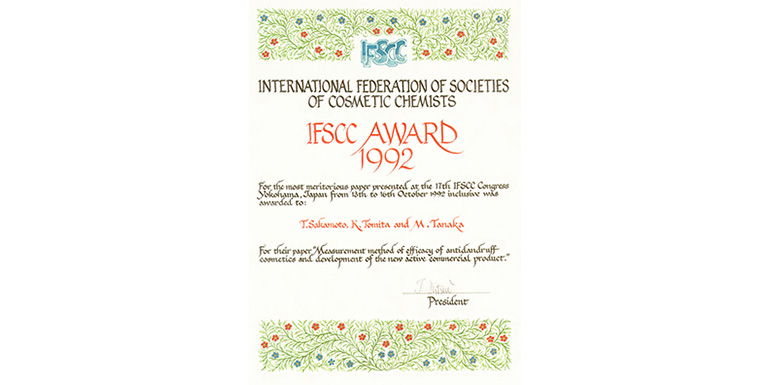- Home
- INNOVATION
- Introducing IFSCC Research Awards
- New findings are gentle on the scalp but hard on dandruff!
Visible to others, dandruff is a serious concern...
New findings are gentle on the scalp but hard on dandruff!
The 17th IFSCC Congress 1992, Yokohama Congress Award
Research on the Evaluation and Development of Dandruff Suppression Agent

What’s new?
The mechanism behind dandruff formation was clarified to develop safer products for dandruff suppression!
Dandruff can appear suddenly. Finding some in the hair or on the shoulder may seem unhygienic. This research clarified the cause of dandruff and provided a starting point for the development of dandruff suppression products from safe components. Safety is the keyword here because antidandruff shampoos and tonics were widely marketed at the time of this award in 1992; however, those products used an antibacterial agent to suppress the bacteria contributing to dandruff formation. Although components were said not to affect the skin, customers were more comfortable using familiar, safe components. This research discovered that dandruff could be suppressed by a component that combines vitamins E and C.
What are the cause and safe treatment of dandruff?
There are two types of dandruff: oily and dry, flaky type. The active ingredient is effective for both!
Prior to developing the component to suppress dandruff, we conducted a thorough research. This started with the collection of dandruff. A brush used for massaging the scalp while washing the hair was modified and placed on the suction hose of a vacuum cleaner to collect dandruff from many people. Loose hair collected in the process was discarded, and only dandruff was selected for the careful study. This revealed that there are two types of dandruff: an oily type and a dry, flaky type.
If you remember the state of the scalp in hot summer, you may remember the presence of sweat and sticky sebum. The scalp has many more sebaceous glands where the sebum is secreted than the face. Also, due to dense hair growth, the scalp is very humid, like the jungle. Such an environment causes rapid increase in the natural bacterial flora on the skin. The growing bacteria feed on the triglycerides in the sebum to produce fatty acid. When the acid remains in contact with the skin for long periods, it stimulates the skin. Sebum also contains a component called squalene, which undergoes oxidation or rusting over time. This oxidized squalene also stimulates the skin.
When the skin is stimulated, it attempts to increase its defense by creating more cells. This causes an irregular turnover of the scalp and shortens the cycle of skin exfoliation. This then becomes the oily type of dandruff. In contrast, the dry type of dandruff is the exfoliation of the skin from deterioration of the skin condition, irregularity of turnover, and inflammation, triggered by a dry scalp.

Previous anti-dandruff products mainly contained antibacterial agents to suppress the bacteria that feed on sebum. This award-winning technology explored components that would prevent stimulation of the skin by oxidation of the fatty acid and squalene due to the antioxidant effect and, at the same time, provide moisture to the scalp. All of this led to the discovery of EPC, a compound of vitamin E and vitamin C. Vitamin E is known to have a strong antioxidant effect, which is strongly supported by vitamin C. However, these components were considered difficult to be formulated together. By combining these components through a substance called phosphate ester, we obtained EPC, which is effective for dandruff.
Dandruff is not always the oily type or the dry type; dandruff may exist as a mixture. Since EPC is compatible with both of these types, the effect in suppressing dandruff is high. These technologies are used in Tohist, an anti-dandruff tonic for women. Furthermore, EPC was also found to have a moisturizing effect, and so is being used in the formulation of a high-function cosmetic cream.
ABOUT US
- Who we are
- History
- Profile
- Governance
- Quality Management
- Supply Network
- Region/Business
BRANDS
- Prestige
- Premium
- Inner Beauty
- Life Quality Makeup
SUSTAINABILITY
- Strategy / Management
- Society
- Environment
- Governance
- Reports / Data
- Related Information
INNOVATION
- Research and Development
- Research Areas
- Research outcomes
- Product safety
- Product Development Policy
- Initiatives for doctors and researchers
CAREERS
INVESTORS
- IR Library